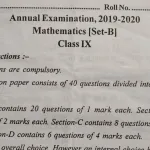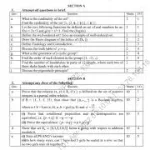This guide is designed to help 12th-grade students prepare for their quarterly exams in 2023. It provides a comprehensive set of questions and answers for all major subjects, aiming to boost confidence and enhance understanding of key topics.
Subject: Mathematics
Question 1
What is the formula for the area of a triangle?
Answer: The formula for the area of a triangle is 12×base×height\frac{1}{2} \times base \times height.
Question 2
What is the Pythagorean theorem?
Answer: The Pythagorean theorem states that in a right-angled triangle, the square of the hypotenuse is equal to the sum of the squares of the other two sides.
Question 3
Explain the concept of a derivative in calculus.
Answer: A derivative represents the rate of change of a function with respect to one of its variables.
Question 4
What is the difference between a permutation and a combination?
Answer: A permutation is an arrangement of objects in a specific order, while a combination is a selection of objects without considering the order.
Question 5
How do you find the solution to a quadratic equation?
Answer: You can solve a quadratic equation using factoring, completing the square, or the quadratic formula.
Question 6
What is the integral of x2x^2?
Answer: The integral of x2x^2 is x33+C\frac{x^3}{3} + C.
Question 7
What is the sum of the first 10 terms of an arithmetic sequence?
Answer: The sum of the first 10 terms of an arithmetic sequence is S10=n2×(2a+(n−1)×d)S_{10} = \frac{n}{2} \times (2a + (n-1) \times d), where n=10n = 10, aa is the first term, and dd is the common difference.
Question 8
What are the basic trigonometric ratios?
Answer: The basic trigonometric ratios are sine, cosine, and tangent, defined as the ratio of sides in a right-angled triangle.
Question 9
What is the principle of mathematical induction?
Answer: Mathematical induction is a method of proving statements for all natural numbers by proving it for the base case and assuming it is true for a given nn.
Question 10
How do you solve simultaneous linear equations?
Answer: Simultaneous linear equations can be solved using substitution, elimination, or matrix methods.
Question 11
What is the difference between an arithmetic and a geometric sequence?
Answer: In an arithmetic sequence, the difference between consecutive terms is constant, while in a geometric sequence, the ratio between consecutive terms is constant.
Question 12
Define a matrix and its types.
Answer: A matrix is a rectangular array of numbers arranged in rows and columns. Types include square, row, column, and diagonal matrices.
Question 13
What is the inverse of a matrix?
Answer: The inverse of a matrix is a matrix that, when multiplied with the original matrix, results in the identity matrix.
Question 14
How do you calculate the probability of an event?
Answer: The probability of an event is calculated as the ratio of favorable outcomes to the total number of possible outcomes.
Question 15
What is a binomial expansion?
Answer: A binomial expansion is the expansion of powers of a binomial expression, expressed as a sum of terms involving coefficients known as binomial coefficients.
Question 16
What is the formula for the area of a circle?
Answer: The formula for the area of a circle is A=πr2A = \pi r^2, where rr is the radius.
Question 17
Explain the concept of limits in calculus.
Answer: A limit is the value that a function approaches as the input approaches a certain point.
Question 18
What is the equation of a straight line?
Answer: The equation of a straight line is given by y=mx+cy = mx + c, where mm is the slope and cc is the y-intercept.
Question 19
How do you calculate the volume of a cylinder?
Answer: The volume of a cylinder is calculated as V=πr2hV = \pi r^2 h, where rr is the radius and hh is the height.
Question 20
What is a complex number?
Answer: A complex number is a number in the form a+bia + bi, where aa is the real part and bibi is the imaginary part.
Subject: Physics
Question 1
What is Newton’s first law of motion?
Answer: Newton’s first law states that an object will remain at rest or in uniform motion unless acted upon by an external force.
Question 2
Define acceleration.
Answer: Acceleration is the rate of change of velocity of an object with respect to time.
Question 3
What is Ohm’s law?
Answer: Ohm’s law states that the current passing through a conductor is directly proportional to the voltage and inversely proportional to the resistance.
Question 4
Explain the concept of gravitational force.
Answer: Gravitational force is the attractive force between two masses. It depends on the masses and the distance between them.
Question 5
What is the formula for kinetic energy?
Answer: The formula for kinetic energy is KE=12mv2KE = \frac{1}{2} mv^2, where mm is mass and vv is velocity.
Question 6
What is the difference between speed and velocity?
Answer: Speed is the rate of change of distance, while velocity is speed in a specific direction.
Question 7
What is the principle of conservation of energy?
Answer: The principle of conservation of energy states that energy cannot be created or destroyed, only converted from one form to another.
Question 8
Define electric field.
Answer: An electric field is a region around a charged particle where a force is exerted on other charged particles.
Question 9
What is the unit of electric current?
Answer: The unit of electric current is the ampere (A).
Question 10
What is the difference between an elastic and inelastic collision?
Answer: In an elastic collision, kinetic energy is conserved, while in an inelastic collision, some kinetic energy is lost.
Question 11
What is Hooke’s law?
Answer: Hooke’s law states that the force exerted by a spring is directly proportional to the displacement from its equilibrium position.
Question 12
What is the formula for work done?
Answer: The formula for work done is W=F×d×cosθW = F \times d \times \cos\theta, where FF is force, dd is distance, and θ\theta is the angle.
Question 13
What is the definition of power in physics?
Answer: Power is the rate at which work is done or energy is transferred. Its unit is the watt (W).
Question 14
What is the law of reflection?
Answer: The law of reflection states that the angle of incidence is equal to the angle of reflection.
Question 15
What is the formula for the force of gravity?
Answer: The formula for the force of gravity is F=Gm1m2r2F = \frac{Gm_1m_2}{r^2}, where GG is the gravitational constant, m1m_1 and m2m_2 are masses, and rr is the distance between their centers.
Question 16
What is the difference between a conductor and an insulator?
Answer: A conductor allows electricity to pass through it, while an insulator resists the flow of electricity.
Question 17
What is the principle behind a transformer?
Answer: A transformer works on the principle of electromagnetic induction to change the voltage of alternating current (AC).
Question 18
What is an electric circuit?
Answer: An electric circuit is a path through which electric current flows, typically consisting of a power source, wires, and a load.
Question 19
What is the significance of the solar constant?
Answer: The solar constant represents the amount of solar radiation received per unit area at a distance of one astronomical unit from the Sun.
Question 20
What is the formula for potential energy?
Answer: The formula for potential energy is PE=mghPE = mgh, where mm is mass, gg is acceleration due to gravity, and hh is height.
This collection of questions and answers is a useful tool for students preparing for their 12th-grade quarterly exams in 2023. By practicing these, students can strengthen their understanding and enhance their performance in the exams.
Latest Posts
- Step-by-step guide to download and apply for jee mains admit card 202
- Comprehensive 2025 government holidays and recruitment details for job seekers
- JEE Mains Admit Card 2025: Your Step-by-Step Guide to Downloading the Hall Ticket
- Everything You Need to Know About 2025 Government Holidays Recruitment
- Comprehensive Guide to rrb d group recruitment 2025 – Eligibility, Vacancies, and Application
- Detailed guide to nps trust recruitment 2025 vacancies, eligibility and apply process
- Comprehensive guide to hpcl recruitment 2025 notification, vacancies, and application process
- ignou bed admission 2025 complete recruitment guide with eligibility and process
- Comprehensive Guide to Indian Army Agniveer Recruitment 2025 Notification and Jobs
- Everything You Must Know About CBSE Board Exams 2025 Changes & New Rules






